




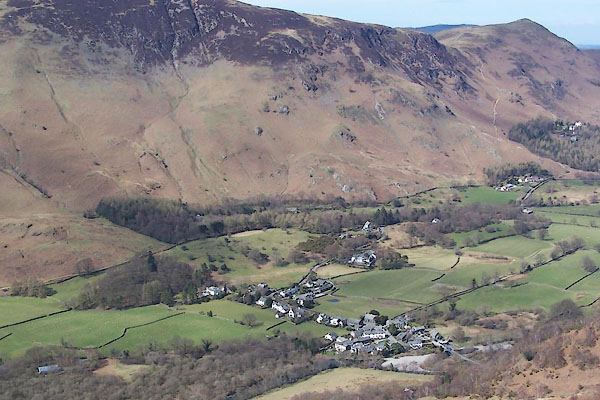
BSM47.jpg (taken 12.4.2010)
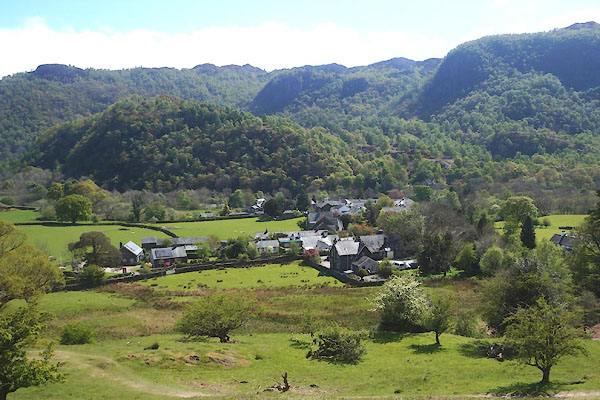
CGA72.jpg From Peace How.
(taken 7.5.2017)
placename:- Grange
placename:- Grange, The
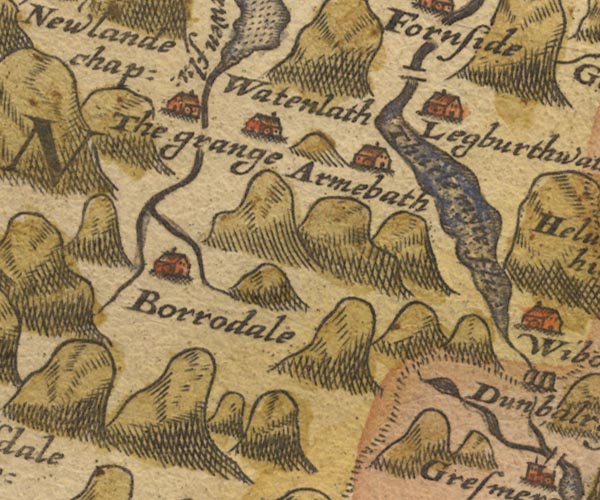
Sax9NY21.jpg
Building, symbol for a hamlet, which may or may not have a nucleus. "The grange"
item:- private collection : 2
Image © see bottom of page
placename:- Grange, The
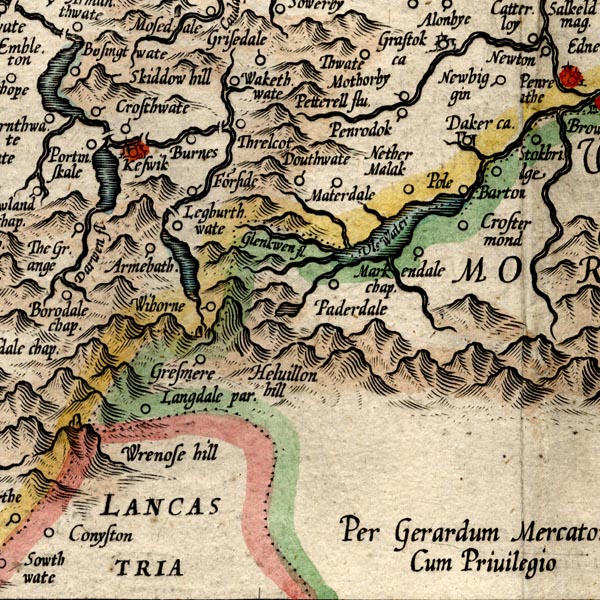
MER8CumF.jpg
"The Grange"
circle
item:- JandMN : 169
Image © see bottom of page
placename:- Grange, The
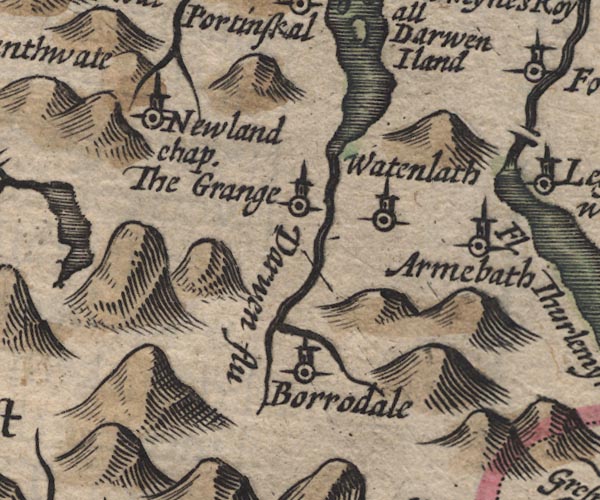
SP11NY21.jpg
"The Grange"
circle, tower
item:- private collection : 16
Image © see bottom of page
placename:- Grange, The
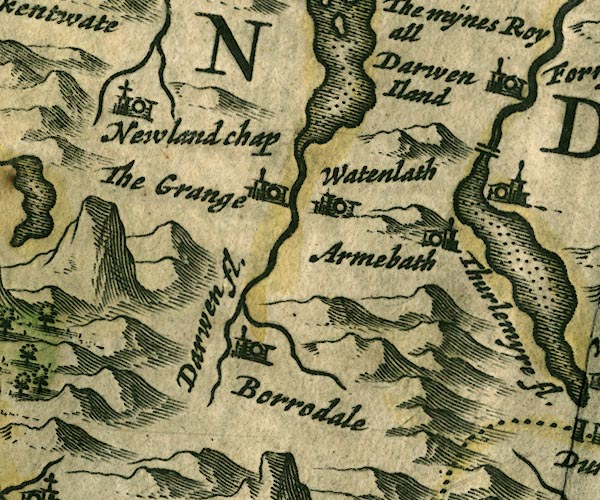
JAN3NY21.jpg
"The Grange"
Buildings and tower.
item:- JandMN : 88
Image © see bottom of page
placename:- Grange

MD12NY21.jpg
"Grange"
Drawing of a house.
item:- JandMN : 90
Image © see bottom of page
 goto source
goto sourceGentleman's Magazine 1751 p.52 "... At the head of Keswic lake, the Darwent is contracted to a narrow river, and runs between two precipices, covered with wood to the top, the perpendicular height of which is 800 yards. On approaching this place we imagined it to be our ne plus ultra, but our guide soon convinced us that we were mistaken. On the West side of the Darwent in this Herculean streight, and directly under one of these stupendous precipices lies the village of Grange. ..."
placename:- Grange

GM1310.jpg
"Grange"
circle; village
item:- JandMN : 114
Image © see bottom of page
placename:- Grange, The
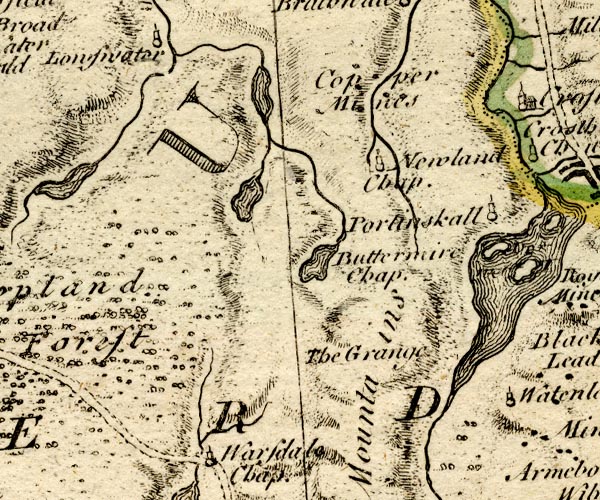
BO18NY11.jpg
"The Grange"
no symbol
item:- Armitt Library : 2008.14.10
Image © see bottom of page
placename:- Grange
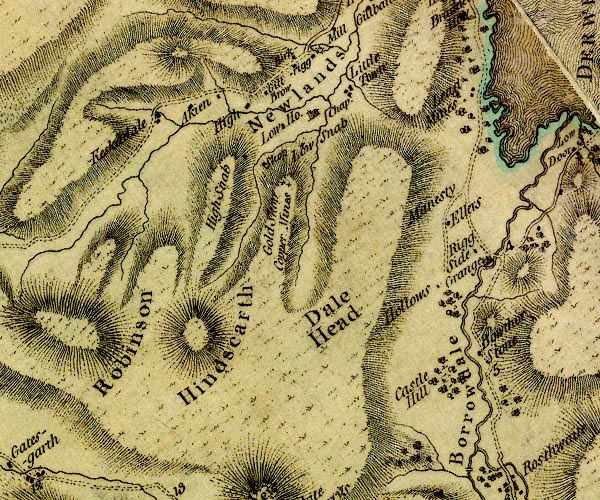
D4NY21NW.jpg
"Grange"
house
item:- Carlisle Library : Map 2
Image © Carlisle Library
item:- tithe; salt; grain
 goto source
goto sourcePage 93:- "... The village of Grange is under it [Castle Crag], celebrated as well for its hospitality to Mr. Gray, as for its sweet romantic site. And to affirm that all that Mr. Gray says of the young farmer at Grange, is strictly applicable to the inhabitants of these mountainous regions in general, is but common justice done to the memory of repeated favours."
"- Hail sacred flood! / May still thy hospitable swains be blest / In rural innocence; thy mountains still / Teem with the fleecy race; thy tuneful woods / For ever flourish: and thy vales look gay. // Armstrong on Health."
 goto source
goto sourcePage 94:- "... The Grange was the place where they [monks of Furness] laid up their grain and their tithe, and also the salt they made at the salt spring, of which works there are still some vestiges remaining, below Grange. ..."
 goto source
goto sourceAddendum; Mr Gray's Journal, 1769
Page 204:- "..."
"... Here we met a civil young farmer overseeing his reapers (for it is now oat harvest) who conducted us to a neat white house in the village of Grange, which is built on a rising ground in the midst of a valley; round it the mountains"
 goto source
goto sourcePage 205:- "form an awful amphitheatre, and through it obliquely runs the Derwent, clear as glass, and showing under its bridge every trout that passes. Beside the village rises a round eminence of a rock covered entirely in old trees, and over that more proudly towers Castle-cragg, ... ..."
"For me , I went no farther than the farmer's (better than four miles from Keswick) at Grange; his mother and he brought us butter that Siserah would have jumped at, though not in a lordly dish, bowls of milk, thin oaten cakes, and ale, and we had carried a cold tongue thither with us. Our farmer was himself the man that last year plundered the eagles' eyrie: ..."
placename:- Grange
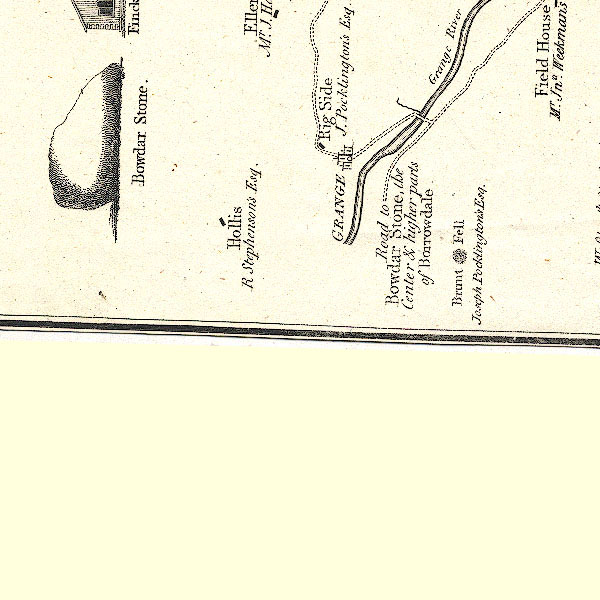
CT2NY21M.jpg
"GRANGE"
item:- Armitt Library : 1959.191.3
Image © see bottom of page
placename:- Grange
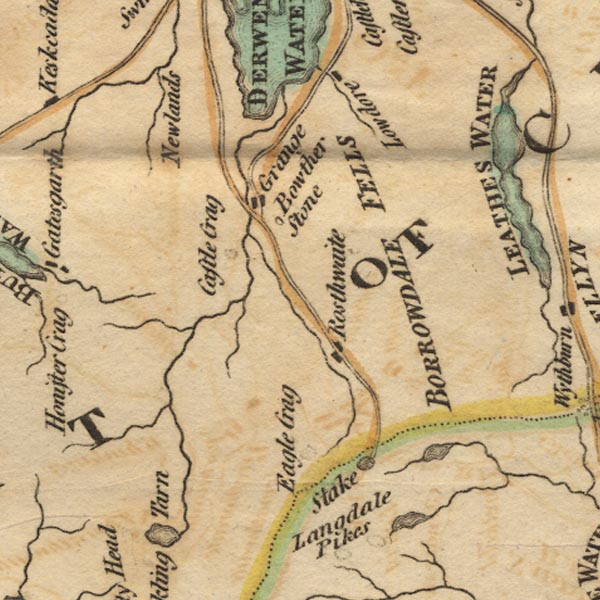
Ws02NY21.jpg
item:- Armitt Library : A1221.1
Image © see bottom of page
placename:- Grainge
 goto source
goto sourcePage 82:- "..."
"We next arrive at Grainge, a pretty well-built village. Mr Gray speaks with raptures of this little place, and after describing his hospitable and kingly feast that was given him, says "And she brought me butter on a lordly dish, which Sisera himself would have envied me the eating.""
"Behind the house of Mr Ab. Banks is a delightful view; for here the river runs close to your feet, and the different objects are disposed in an extremely beautiful and picturesque manner."
placename:- Grainge

CL152518.jpg
"GRAINGE"
scatter of buildings
item:- private collection : 169
Image © see bottom of page
placename:- Grange
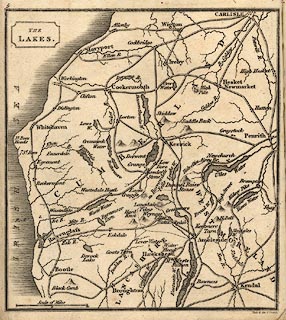 click to enlarge
click to enlargeGRA1Lk.jpg
"Grange"
blocks, italic lowercase text, village, hamlet, locality
item:- Hampshire Museums : FA2000.62.5
Image © see bottom of page
placename:- Grange, The
item:- tithes
 goto source
goto sourceGentleman's Magazine 1805 p.1123 "..."
"The Grange is a small village in the mouth of Borradaile, once used as the repository of their tithe-grain by the Monks of Furness. A little stone bridge thrown across the river here is nearly gone to decay: here we saw the farm house, whither Mr. Gray fled for shelter from the inhospitable frowns of Borradaile. ..."
placename:- Grange
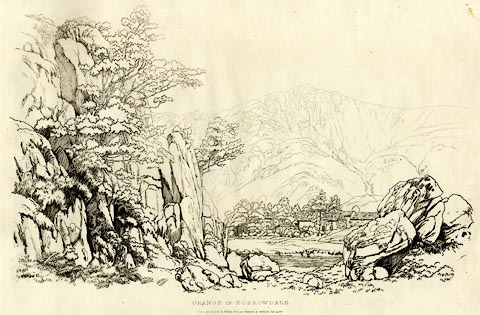 click to enlarge
click to enlargeGN1239.jpg
Plate 39 in Sixty Studies from Nature, 1810.
printed at top right:- "39"
printed at bottom:- "GRANGE IN BORROWDALE. / Drawn and Engraved by William Green and Published at Ambleside, June 24, 1808."
watermark:- "J WHATMAN / 1813"
item:- Armitt Library : A6641.39
Image © see bottom of page
placename:- Grange, The
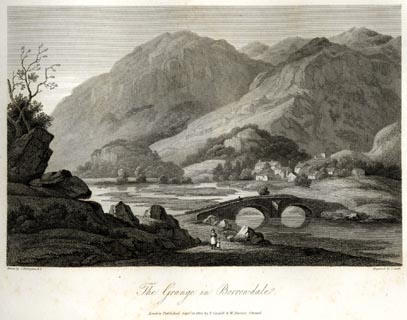 click to enlarge
click to enlargeFA0407.jpg
printed, bottom left, right, centre "Drawn by J. Farington R.A. / Engraved by J. Scott. / Grange in Borrowdale. / London Published Septr. 15, 1815, by T. Cadell &W. Davies, Strand."
Descriptive text:- "THE GRANGE IN BORROWDALE."
"THE Village of Grange consists of a few houses, or rather cottages, situated on the west side of the river Derwent, about a mile above its entrance into the Lake. This village is a mile distant from the Waterfall of Lowdore, and about five miles from Keswick. In this spot is formed, by the impending mountains, what Mr. Gray calls the Gorge, or narrow pass of Borrowdale. The cottages, built apparently without mortar, have been erected so long ago that the stones have acquired the same weather-worn colour, as those which lie on the mountain-side behind them. A few pines rise over them; the mountains appear to meet a little way on, and form an amphitheatre; and where they meet, their base is richly clothed with coppice-wood and young trees. The river Derwent, clear, shallow, and melodious, washes the stone bank on which the greater number of the pines grow, and forms the fore-ground, with an old bridge of two arches, as rude in construction as the cottages. A small insulated rock, called Castlet Crag, nearly covered with trees, is a marked feature in this scene. Concealed from the sight of it by the precipice on the fore-ground, stands Castle Crag, which is delineated in the following engraving. The dale, secluding itself beyond this hill, continues to exhibit, for a few miles, the wildest and most romantic scenes, forming a striking contrast to the open display of magnificence which characterises the vale of Keswick. The Derwent affords easy passage to boats from the Lake, part of the way to the bridge; but there is seldom water sufficient for the boats to proceed to that point. The course of the river is winding, and the water is so beautifully clear, that the bed of the river may be distinctly seen at a great depth. Borrowdale abounds in valuable mines, from some of which are obtained the finest wadd, or black lead, to be found in England. Iron, slate, and free-stone of various kinds, are also the treasures of these mountains."
item:- Armitt Library : A6666.7
Image © see bottom of page
placename:- Grange
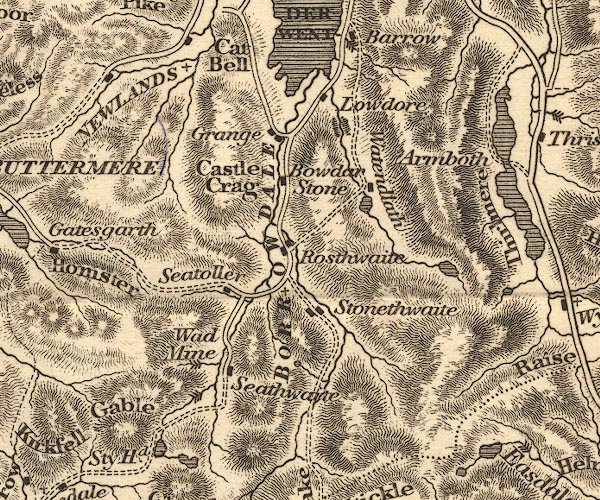
OT02NY21.jpg
item:- JandMN : 48.1
Image © see bottom of page
placename:- Grange
 goto source
goto sourcePage 56:- "... Further on is a scene greatly and deservedly admired, we mean the bridge and village of Grange, planted on the west banks of the Derwent; the sweetly-wooded Holme Crag and other knolls swell above the houses, over which masses of rock and precipitous crags sublimely tower. ..."
 goto source
goto sourcePage 166:- "..."
"Grange is a small village, at the entrance of the narrow pass which leads into Borrodale."
"Manesty.- Near this place is a medicinal spring; and the retrospective view over its woods into Borrodale, is magnificent, especially if seen under the influence of a setting sun."
placename:- Grange
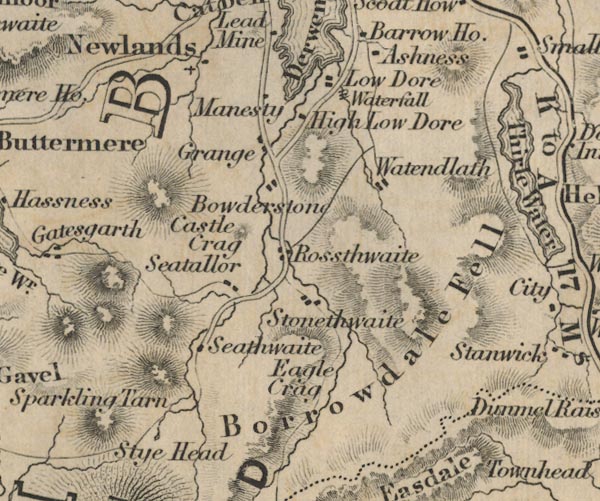
FD02NY21.jpg
"Grange"
item:- JandMN : 100.1
Image © see bottom of page
placename:- Grange
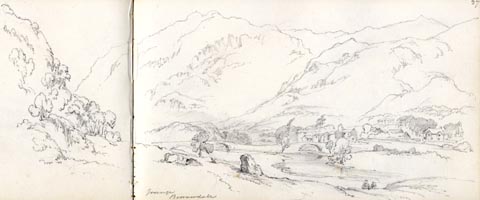 click to enlarge
click to enlargeAS0533.jpg
"Grange / Borrowdale"
page number "27"
item:- Armitt Library : 1958.389.33
Image © see bottom of page
placename:- Grange
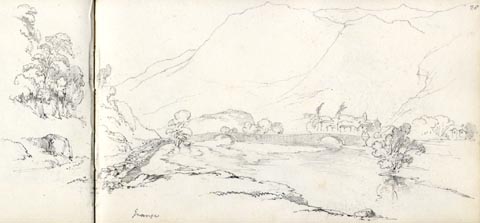 click to enlarge
click to enlargeAS0535.jpg
"Grange"
page number "28"
item:- Armitt Library : 1958.389.35
Image © see bottom of page
placename:- Grange

GAR2NY21.jpg
"Grange"
blocks, settlement
item:- JandMN : 82.1
Image © see bottom of page
item:- drawing
 goto source
goto sourcePage 81:- "... A mile further lies Grange, at the entrance of the dale, with its undulating bridges crossing the windings of the river. When the Abbots of Furness owned the whole of Borrowdale, a few monks were placed at its entrance, to receive and guard the crops; and this place was their granary. It is now a picturesque hamlet, which must be familiar to all who haunt exhibitions of pictures. Nobody who carries a pencil can help sitting down on the grass to sketch it. ..."
placename:- Grange
item:- development
placename:- Grange
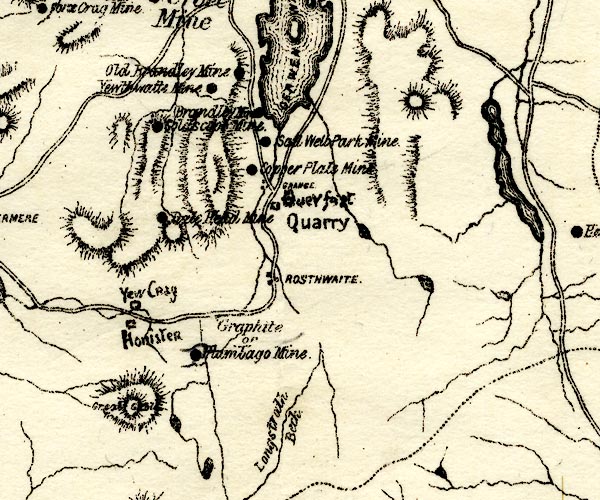
PST2NY21.jpg
"GRANGE"
dots, roads
item:- JandMN : 162.2
Image © see bottom of page
 click to enlarge
click to enlargeRG0103.jpg
"1 Point of Ullock 2 Langside 3 Carlside 4 Carsledam 5 Skiddaw 6 Skiddaw Low Man 7 Little Man 8 Jenkin Hill 9 Lonscale Fell 10 Littledale Pike / Latrigg (below) / Castle Head (still lower) 11 Skiddaw Forest 12 High Row Fell 13 Saddle Back &14 Falcon Crag 15 Barrow 16 High Wood Crag 16 Castle Rigg / Lowdore (below)"
On p.150 in the Red Guide guide book, Guide to the English Lakes.
item:- JandMN : 102.4
Image © see bottom of page
item:- stepping stones
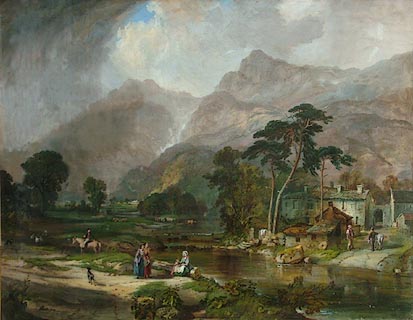 click to enlarge
click to enlargePR0868.jpg
Borrowdale 1846 oil on canvas by Sam Bough. View of Grange village in Borrowdale, the Lake District. It shows the Lakeland valley in summer with clouds gathered over the fells which rise beyond the valley. On the right stands a small stone mill, partially obscured by a stand of tall trees; two men stand conversing on the path which fords the river crossing composition diagonally from lower right corner. In the foreground two women pause in a patch of sunlight to talk to a third woman seated on a log beside the river. To their left a man on horseback turns in his saddle to regard them. To extreme left, a small flock of sheep are accompanied by a sheepdog; in middle distance a herd of cattle stand in the river beyond. Bough has dramatically altered the appearance of the valley by exaggerating the size of the fells in this painting which resemble the Scottish highlands and show a considerable amount of artistic licence. Bough would have sketched this view of Grange on the spot on his occasional visits to the Lake District, completing the finished oil painting back in his studio.
signed &dated at bottom centre:- "Sam Bough 1846"
item:- Tullie House Museum : 1917.89.1
Image © Tullie House Museum
placename:- Grange
 click to enlarge
click to enlargePR0026.jpg
vol.1 pl.71 in the set of prints, Westmorland, Cumberland, Durham and Northumberland Illustrated.
printed at bottom left, right, centre:- "T. Allom. / J. C. Bentley. / CASTLE CRAG, BORROWDALE, FROM THE VILLAGE OF GRANGE, CUMBERLAND."
item:- Dove Cottage : 2008.107.26
Image © see bottom of page
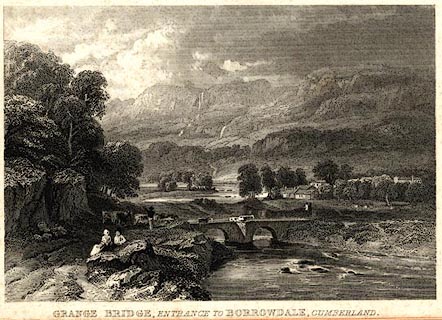 click to enlarge
click to enlargePR0576.jpg
printed at bottom:- "GRANGE BRIDGE, ENTRANCE TO BORROWDALE, CUMBERLAND"
item:- Dove Cottage : 2008.107.524
Image © see bottom of page
placename:- Grange, The
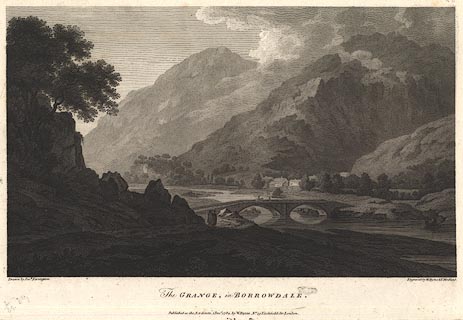 click to enlarge
click to enlargeBMZ90.jpg
Grange Bridge over the River Derwent, Grange village and Low Scawdel and High Scawdel in the background?
Plate 2 from Views of the Lakes, &c, in Cumberland and Westmorland, published 1789; with descriptive text:- "THE GRANGE IN BORROWDALE."
"CONSISTS of a few Houses standing on the West Side of the River Derwent, about a Mile above its Entrance into the Lake. This Village is a Mile distant from the waterfall of Lowdore, and about five from Keswick. In this spot is formed by the impending Mountains what Mr. Gray calls 'THE GORGE OF BORROWDALE.' ..."
item:- Dove Cottage : Lowther.54
Image © see bottom of page
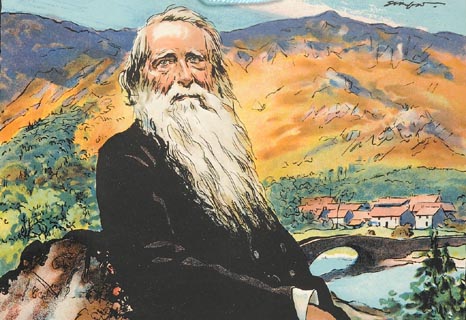 click to enlarge
click to enlargePR1418.jpg
John Ruskin seated on rock in foreground. Grange village Borrowdale in background.
signed at top right on print:- "Simpson"
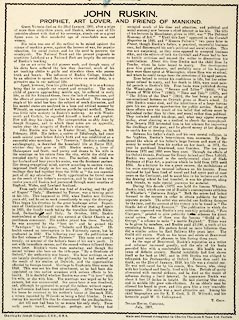 click to enlarge
click to enlargePR1419.jpg
text by T Gray about John Ruskin in Lakeland on reverse of coloured print by Joseph W Simpson, 1938.
item:- Tullie House Museum : 2009.210.3
Images © Tullie House Museum
Of fell and valley, bridge and clustered farm,
Make them thine own, no absence shall destroy
The hamlet's peace, the ancient river's joy.
H.D.R."
 |
NY252181 Borrowdale Freeholds (Borrowdale) |
 |
NY25101773 Borrowdale Gates Hotel (Borrowdale) |
 |
NY25471759 Butts, The (Borrowdale) |
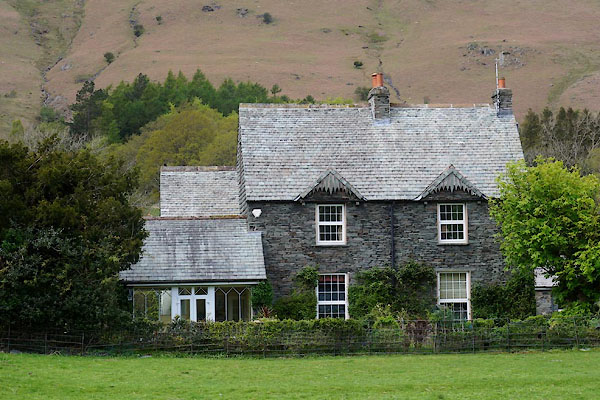 |
NY25161752 Castle Crag (Borrowdale) |
 |
NY24821792 Ellers (Borrowdale) |
 |
NY25931802 Field House (Borrowdale) |
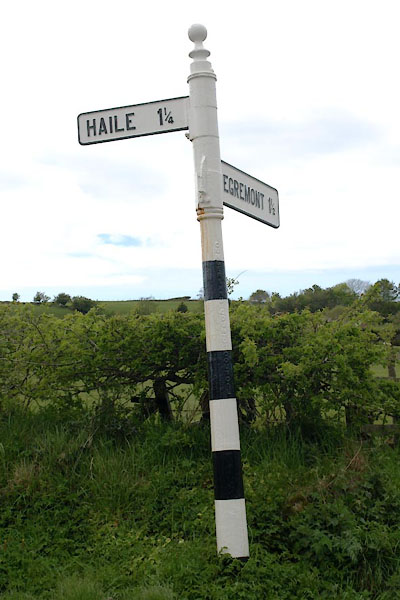 |
NY03201043 fingerpost, St John Beckermet (St John Beckermet) |
 |
NY25411736 Garthwaite Gate (Borrowdale) gone |
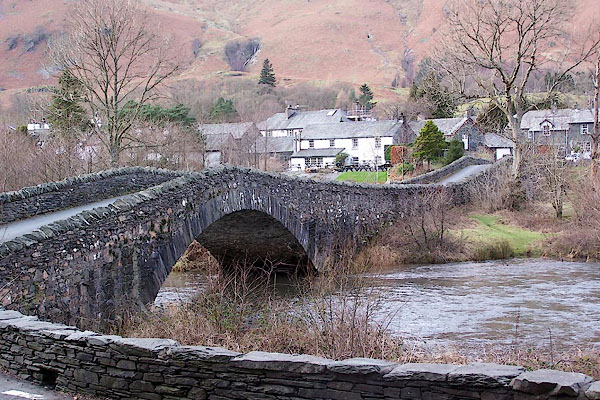 |
NY25371747 Grange Bridge (Borrowdale) L |
 |
NY25311744 Grange Farm House (Borrowdale) L |
 |
NY03141023 Grange Quarry (St John Beckermet) |
 |
NY25361748 Hen How (Borrowdale) |
 |
NY24791775 High Close (Borrowdale) |
 |
NY25021781 High Rigg (Borrowdale) |
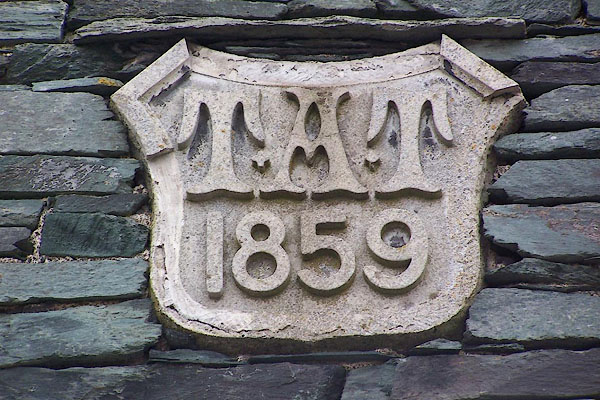 |
NY252174 house, Grange (Borrowdale) |
 |
NY25281745 Howe Cottage (Borrowdale) |
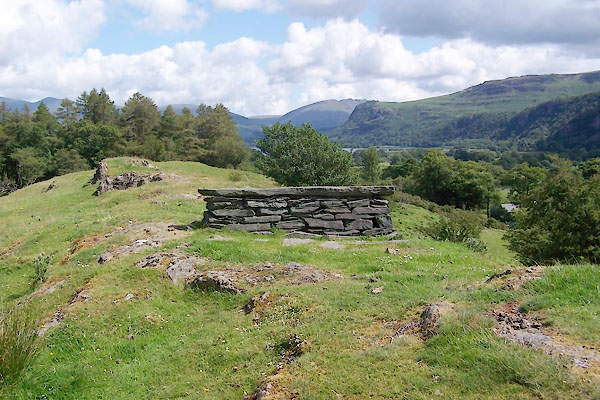 |
NY24911760 Peace Howe (Borrowdale) |
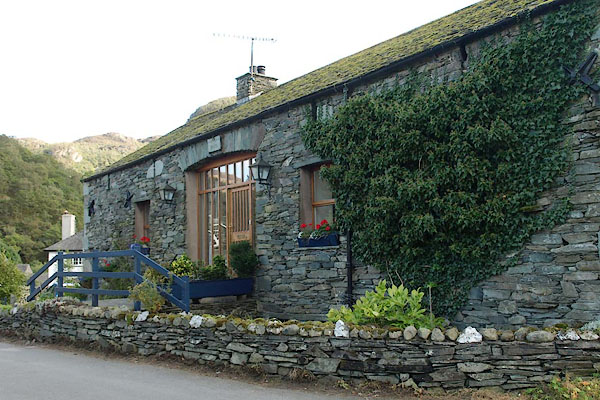 |
NY25251748 Pennybrig (Borrowdale) |
 |
NY25121754 Rigg Side (Borrowdale) |
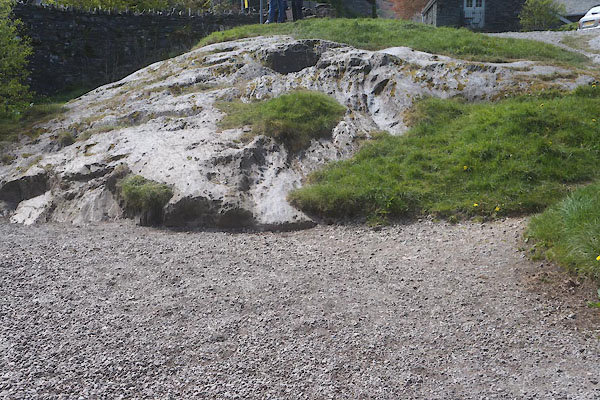 |
NY25371748 roche moutonee, Grange (Borrowdale) |
 |
NY24831701 Scarbrow Wood (Borrowdale) |
 |
NY251175 Scarthwaite (Borrowdale) |
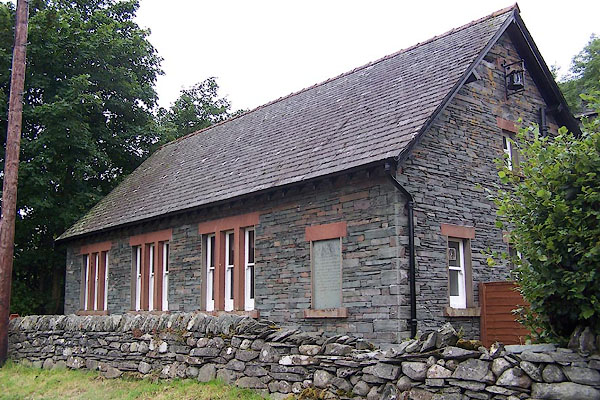 |
NY25091752 Grange School (Borrowdale) |
 |
NY24701747 Swanesty How (Borrowdale) |
 |
NY25011788 Swanesty (Borrowdale) |
 |
NY25671768 Wall Gate (Borrowdale) gone |
 |
NY25601768 Wallgate Green (Borrowdale) |
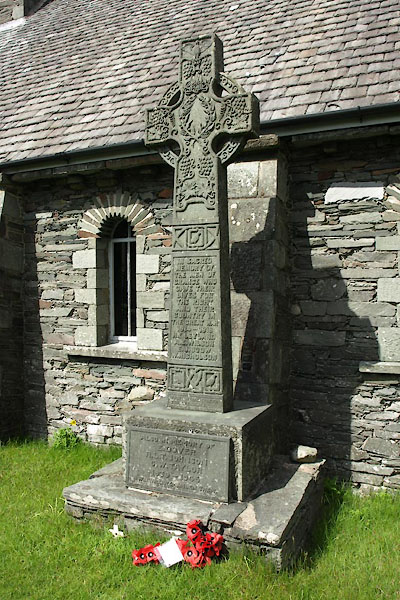 |
NY25251751 war memorial, Grange (Borrowdale) |
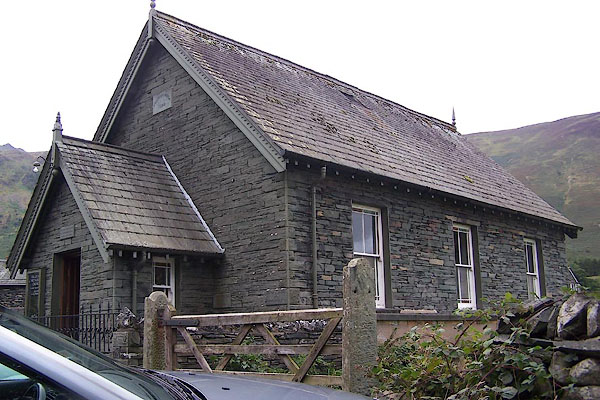 |
NY25341750 Wesleyan Church (Borrowdale) |
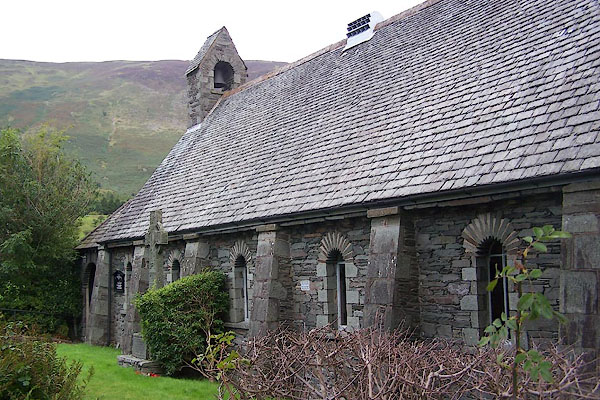 |
NY25251751 Holy Trinity Church (Borrowdale) |
